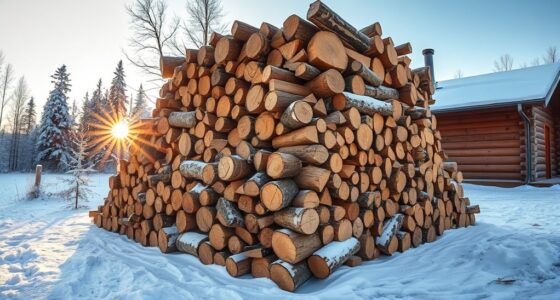Hardwood species like oak, maple, and birch are top choices for small stoves because they burn efficiently, produce high heat, and generate less creosote buildup. These woods are dense, ensuring a longer-lasting, cleaner burn. Properly seasoned, dry firewood of these types enhances safety and efficiency. If you want to discover more about selecting the best firewood for your small stove and how to prepare it properly, there’s plenty of useful details ahead.
Key Takeaways
- Hardwoods like oak, maple, and hickory burn longer and produce more heat, ideal for small stove efficiency.
- Softwoods such as pine and spruce ignite quickly but burn faster, suitable for short-term heating needs.
- Choose well-seasoned firewood with low moisture content (below 20%) for cleaner, safer combustion.
- Prefer species that produce minimal creosote buildup, reducing chimney maintenance and fire hazards.
- Local native species often provide sustainable and readily available firewood options for small stove use.

Are you wondering what type of firewood works best for small stoves? If so, understanding how to select the right wood can make a big difference in your heating efficiency and the overall experience. Small stoves generally require firewood that burns hot, clean, and steadily, which means choosing the right species is vital. One of the key factors is firewood seasoning—properly dried wood that has been seasoned for at least six to twelve months will ignite more easily, produce less creosote, and generate more heat. When you focus on firewood seasoning, you guarantee that your stove operates efficiently, minimizes smoke, and maintains safety. Additionally, selecting firewood from sustainable harvesting practices helps protect forests and guarantees a steady supply of quality wood without damaging ecosystems. Proper firewood seasoning involves stacking the wood in a dry, well-ventilated area, protected from rain and snow, and turning it periodically to ensure even drying. This process not only improves performance but also supports sustainable harvesting—by sourcing your wood responsibly, you help prevent overharvesting and preserve forest health. Ensuring the moisture content is low enhances combustion efficiency and reduces harmful emissions during burning. Properly seasoned, sustainably harvested firewood also reduces the buildup of harmful creosote in your chimney, decreasing fire hazards. Using moisture meters can help accurately assess whether your firewood is properly seasoned before burning. Incorporating proper storage techniques can further enhance the drying process and maintain wood quality over time.
Frequently Asked Questions
What Is the Best Firewood for Small, Portable Stoves?
For your small, portable stove, hardwoods like oak or maple are ideal because they have high wood density, which means they burn longer and produce more heat output. These species ignite easily and burn steadily, giving you reliable warmth. Avoid softwoods like pine, as they burn quickly and produce less heat. Choosing dense, seasoned firewood guarantees efficient combustion and better heat for your stove.
How Do Moisture Levels Affect Firewood Burning Efficiency?
Moisture content directly impacts your firewood’s combustion efficiency. When your firewood has high moisture levels, it takes more energy to evaporate the water, resulting in less heat and more smoke. To burn efficiently, you should aim for firewood with low moisture content, ideally under 20%. Properly seasoned wood burns cleaner, produces more heat, and reduces creosote buildup in your small stove, ensuring safer, more effective heating.
Are There Eco-Friendly Firewood Options Suitable for Small Stoves?
Yes, there are eco-friendly firewood options for your small stove. Look for sustainably harvested wood, which guarantees responsible forest management and reduces environmental impact. Choose firewood packaged in biodegradable packaging to minimize waste. Using sustainably sourced, biodegradable options helps you burn efficiently while supporting eco-conscious practices. This way, you enjoy warm fires and protect the environment at the same time.
How Should I Store Firewood to Maintain Quality?
You should store firewood in a dry, well-ventilated area to maintain quality. Use a storage container, like a wood rack or a covered bin, to protect it from moisture and rain. During the seasoning process, avoid stacking wood directly on the ground to prevent rot. Proper storage helps the firewood dry thoroughly, ensuring it burns efficiently and safely in your small stove.
Can I Use Seasoned Wood in My Small Stove?
Yes, you can definitely use seasoned wood in your small stove. Seasoned wood benefits include lower moisture content, which helps your stove burn more efficiently and produces less creosote buildup. Using seasoned wood enhances small stove efficiency, providing you with more heat and less smoke. Make sure your wood is properly dried for at least six months to maximize these benefits and enjoy a cleaner, warmer fire.
Conclusion
Choosing the right firewood for your small stove is like selecting the perfect brush for a masterpiece—you want it to burn bright and steady. I once watched my neighbor’s small stove glow warmly during a chilly evening, filling his cozy cabin with comfort. Remember, the right wood not only heats your space efficiently but also creates a warm haven you’ll cherish. Make your selection wisely, and your home will glow with warmth all winter long.










